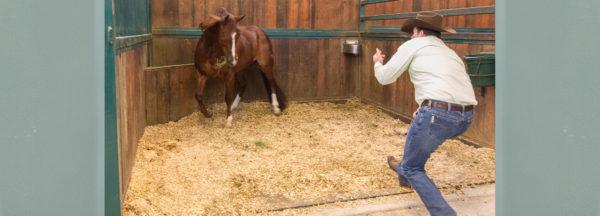Training Tip: Stall Cleaning


Training Tip: Working on Respect While Cleaning Your Horse's Stall
Clinton Anderson from Downunder Horsemanship has developed a way to train horses, regardless of their past problems or traumas. It all begins with training the owners so they can gain their horse’s respect and understand how to properly control them. Join Clinton on his weekly endeavors of tackling some of the most challenging situations with problem horses, and problem owners. This week, we watch as Clinton shows us a trick about interacting with your horse during stall cleaning.
Clinton starts the episode by reminding viewers that every time you interact with your horse, you’re teaching them something. You’re either teaching them to be more respectful and obedient or you’re teaching them to be pushier and more disrespectful. That’s why Clinton is extremely particular about who comes in contact with his horses. If you let just anyone handle your horses, they may be teaching them something that derails your progress—especially bad behavior.
Even an interaction as simple as cleaning a horse’s stall can teach them something. Clinton reminds viewers that when interacting with horses whoever moves first, loses. The more you can make your horse’s feet move forwards, backwards, left, and right, the more respect the horse has for you and the more they use the thinking side of their brain. On the other hand, the more you move around to accommodate your horse, the pushier and more disrespectful they become.
To give us an example of this, Clinton shows us how to clean a stall and interact with a horse. You always have two choices. You can either walk around the horse and clean where you need to, or you can make a little game of it. If you need to clean an area of the stall where the horse is at, raise your pitchfork and create a bit of energy so the horse backs out of your space and gives you room to do what you need to do. When he responds, give a little praise or a little rub to show your appreciation and communicate that he did good. Need to move over to the other side of the stall? Repeat the process. Create a little energy with the pitchfork and your horse will move out of the way. You can direct your horse to move in any direction you need, as long as you’re strategic about how you approach it. Obviously for this to work, you must have already taught your horse how to respond to your body language and pressure when you taught him the Fundamentals groundwork exercises. This is how you refine what you’ve learned and keep reinforcing it. Clinton explains that he’s just trying to show people—and give you inspiration and ideas—how you can train your horse at home.
By following this approach, you get a bit of extra training during mundane tasks. You should maintain this mindset when you’re saddling, unsaddling, in the wash rack or stall with your horse. Anytime you can get a horse’s feet to move and yours to stay still, you’re gaining respect. You’re getting the horse to use the thinking side of their brain and squash bad behaviors before they start. Plus, the more you use these techniques, the more your horse will listen to you.
Clinton Anderson has spent the past 20 years of his life devoting his time to creating the best training tools and videos available to horsemen all over the world. The Downunder Horsemanship app offers over 100 hours of free in-depth training content. No Worries Club members will have full access to Clinton’s ever-growing training library and a massive number of members only features and information. And the best part is that you can view and interact with each lesson on your mobile device or computer, giving you ultimate access to the Method anytime and anyplace.
To learn more about the Clinton Anderson training method, become a member of the No Worries Club, or to get information on any of the products seen on our show, head over to our homepage and download the Downunder Horsemanship app today!

